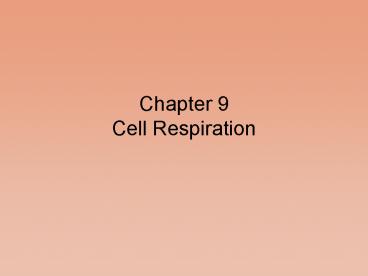Chapter 9 Cell Respiration - PowerPoint PPT Presentation
Title:
Chapter 9 Cell Respiration
Description:
Cellular respiration is the process that releases energy by breaking down ... Used in bread making. Lactic acid fermentation. Produces lactic acid, NAD ... – PowerPoint PPT presentation
Number of Views:33
Avg rating:3.0/5.0
Title: Chapter 9 Cell Respiration
1
Chapter 9Cell Respiration
2
(No Transcript)
3
Cell Respiration
- Food provides living things with the energy
needed to live and reproduce - Energy in food is measured in calories
- Energy to raise 1 g water 1C
- Calorie 1000 calories
- The process of releasing energy from glucose
starts with a pathway called glycolysis.
4
Energy Options
5
Overview of Cell Respiration
- Cellular respiration is the process that releases
energy by breaking down glucose and other food
molecules in the presence of oxygen. - Chemical equation C6H12O6 6O2 ? 6CO2 6H2O
energy exact opposite of photosynthesis this
makes a cycle
6
Cell Respiration glycolysis, Krebs cycle,
electron transport chain
7
Glycolysis
- Glycolysis is process in which one molecule of
glucose is broken in half, producing two
molecules of pyruvic acid, a 3-carbon compound - - Occurs in cytoplasm of cell
- The energy from glycolysis is stored in 2 ATP
molecules - 4 high-energy electrons are accepted by NAD to
make NADH, which goes to the electron transport
chain
8
Glycolysis
9
Energy in Absence of Oxygen
- Fermentation releases energy from food without
using oxygen known as anaerobic respiration not
in air - Fermentation starts with glycolysis and then
converts NADH to NAD to allow glycolysis to
continue producing ATP
10
- There are 2 main types
- Alcoholic fermentation
- produces ethyl alcohol, carbon dioxide NAD
- Carried out by yeast and other microscopic
organisms - Used in bread making
11
- Lactic acid fermentation
- Produces lactic acid, NAD
- Occurs in your muscles when there is not enough
oxygen and unicellular organisms - Results in cramps because lactic acid builds up
- Used in production of cheese, yogurt, buttermilk,
sour cream
12
The Krebs cycle
- During the Krebs cycle, pyruvic acid from
glycolysis is used to make carbon dioxide, NADH,
ATP, and FADH2.
13
Electron Transport
- The electron transport chain used high-energy
electrons from the Krebs cycle to convert ADP to
ATP.
14
Net ATP Production
15
Glucose
2 Pyruvic acid
Krebs Cycle
16
Energy and Exercise
- A runner has enough stored ATP for about 50
meters, then the muscles need to use lactic acid
fermentation to produce ATP in addition to
cellular respiration last about 90 seconds
17
- Your body stores long-term energy in the form of
the carbohydrate glycogen (15-20 minute store),
then as fats these are broken down for exercise
longer than 90 seconds
18
Comparing Photosynthesis and Cellular Respiration
Photosynthesis Cellular Respiration
Function Energy capture Energy release
Location Chloroplasts Mitochondria
Reactants CO2 and H2O C6H12O6 and O2
Products C6H12O6 and O2 CO2 and H2O
Equation 6CO2 6H2O energy ? C6H12O6 6O2 6CO2 6H2O energy ? C6H12O6 6O2































